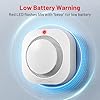If you have a heat detector in your home, you may be wondering how to test it to make sure it is working properly. One way to test your heat detector is with a magnet.
Testing a heat detector with a magnet can be helpful in determining if there is a problem with the detector. The magnet can help to determine if the detector is working properly by detecting when the magnetic field is changed. Testing the detector can also help to determine if the sensor is working correctly.
Contents
How to properly test your heat detector with a magnet?
There are two ways to test your heat detector: with a magnet or with a multimeter. If you have a magnet, you can test your heat detector by holding the magnet close to the detector. The detector should sound an alarm. If you don’t have a magnet, you can test your heat detector with a multimeter.
First, set the multimeter to the Ohm setting. Then, touch the multimeter’s probes to the two terminals on the heat detector. The multimeter should read a resistance of less than one ohm.
The importance of testing your heat detector regularly
It is important to test your heat detector regularly to ensure it is operating correctly and will raise the alarm in the event of a fire. A heat detector is a vital part of your fire safety system and can be the difference between a small fire and a major disaster.
There are two types of heat detectors – rate-of-rise and fixed temperature. Rate-of-rise heat detectors are designed to detect a rapid increase in temperature, while fixed temperature heat detectors will sound the alarm when the temperature reaches a certain level.
To test a heat detector, you will need a magnet. For rate-of-rise heat detectors, hold the magnet close to the detector for two seconds. The detector should sound the alarm. For fixed temperature heat detectors, you will need to heat the detector with the magnet. Hold the magnet close to the detector for three to five seconds. The detector should sound the alarm.
If your heat detector does not sound the alarm when it should, it may need to be replaced. A heat detector is a vital part of your fire safety system, so it is important to ensure it is working correctly. Test it regularly and replace it if necessary.
How to ensure your heat detector is functioning correctly?
A heat detector is a vital part of any fire safety system, so it’s important to ensure that it is functioning correctly. The best way to test a heat detector is to use a magnet.
First, hold the magnet close to the heat detector. If the detector is working properly, the magnet should trigger the detector to sound an alarm.
If the detector does not sound an alarm, it may be malfunctioning and should be replaced.
What to do if your heat detector is not working?
If you have a heat detector that is not working, there are a few things that you can do to troubleshoot the problem.
First, check the batteries. If the batteries are dead, then the heat detector will not be able to detect any heat. Replace the batteries and see if that solves the problem.
Next, check the wiring. If the wiring is loose or damaged, then the heat detector will not be able to function properly. Tighten any loose connections and replace any damaged wires.
Finally, check the sensitivity of the heat detector. If the heat detector is not sensitive enough, it will not be able to detect all of the heat in a room. Adjust the sensitivity until the heat detector is able to detect all of the heat in the room.
How to troubleshoot your heat detector?
It’s not uncommon for heat detectors to go off when there’s no fire. This can be frustrating, but it’s important to remember that heat detectors are designed to be sensitive to heat, so they will go off when they sense an increase in temperature.
There are a few things you can do to troubleshoot your heat detector and make sure it’s working properly.
First, check the batteries. If the batteries are low, the heat detector may not be able to sense a fire. Replace the batteries and test the heat detector again.
If the heat detector still goes off when there’s no fire, it’s possible that it’s not positioned correctly. Make sure the heat detector is mounted on a wall or ceiling and that it’s not obstructed by furniture or other objects.
If the heat detector is mounted correctly and the batteries are fresh, but it still goes off when there’s no fire, it’s possible that the heat detector is defective. In this case, you’ll need to replace the heat detector.
How to properly maintain your heat detector?
If you have a heat detector in your home, it’s important to test it regularly to ensure it’s working properly. The best way to test a heat detector is with a magnet.
To test your heat detector with a magnet, simply hold the magnet up to the detector. If the detector is working properly, the magnet should trigger the alarm. If the detector doesn’t sound an alarm, it may be time to replace the batteries or the detector itself.
It’s also important to regularly clean your heat detector to prevent false alarms. To clean your heat detector, simply remove the detector from its mount and wipe it down with a damp cloth. Be sure to avoid getting the detector wet, as this could damage the electronics.
Once you’ve cleaned the heat detector, it’s a good idea to test it again with the magnet to ensure it’s still working properly.
By testing your heat detector regularly and keeping it clean, you can be sure it will be there to protect you and your family in the event of a fire.
Tips for using your heat detector effectively?
- 1. Install your heat detector in an area where it can best sense heat: near the kitchen or in a room with a lot of heat-generating appliances.
- 2. Test your heat detector regularly to ensure it is working properly.
- 3. If you have a battery-operated heat detector, check the batteries regularly and replace them as needed.
- 4. If you have a hard-wired heat detector, make sure it is connected to a working power source.
- 5. Keep your heat detector clean and free of debris.
- 6. If you experience a power outage, your heat detector will still work if it is battery-operated.
- 7. If you have a question or concern about your heat detector, contact the manufacturer or a qualified electrician.
Summary
If you have a heat detector in your home, you may be wondering how to test it to make sure it’s working properly. A heat detector is a vital part of your home’s fire safety system, so it’s important to test it regularly.
One way to test your heat detector is to use a magnet. Simply hold the magnet up to the detector and see if the alarm sounds. If it does, then your detector is working properly. You can also test your heat detector by holding a match or lighter up to it. The detector should sound an alarm if the temperature gets too hot.
Regularly testing your heat detector is a good way to ensure your family’s safety in case of a fire. If you have any concerns about your detector, be sure to contact a professional.



















